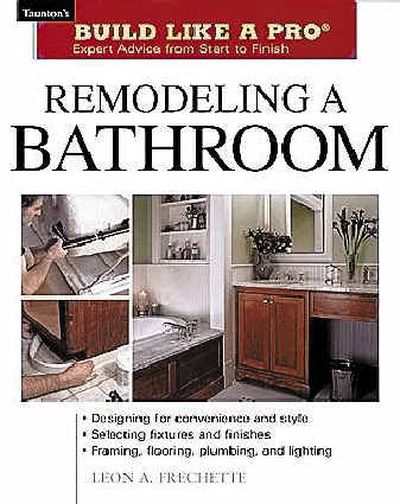Don’t start remodeling without it

The thought of starting almost any remodeling project fills me with joy. Here is the chance to make everything better — to fix the cracks and leaks and everything that had been MacGyvered together by the less-detail-oriented people who lived in our 1912 house before us.
But when it comes to plumbing or electrical work, I start hallucinating worst-case scenarios that involve ruptured pipes, gallons of spewing water, mismatched wires and walls that spontaneously combust.
So thank you, Leon A. Frechette, for writing “Remodeling a Bathroom” ($19.95, The Taunton Press), a straightforward guide to spiffing up the old water closet. Like a bible of bathroom remodeling, it is an excellent place to turn for solace and direction.
The book is laid out logically in chapters progressing from demolition and framing, plumbing and electrical rough-in to doors and moldings and finishing up with fixtures.
Frechette, who lives on Spokane’s South Hill, used his own bathroom remodel as material for the book. There are pictures of him crimping pipe and hanging wallboard, and readers get to watch his bathroom transform from dated and cramped to naked lath to sleek and roomy.
There are helpful pictures on every page. Most highlight specific details, like how properly troweled mastic should look, or the best cut for a nozzle on a tube of caulk. Others show tools, like a right-angle drill or a pneumatic gun.
Diagrams point out things like installing three-way electrical switches and how to lay out pipes and vents so everything flows the right way.
Frechette does a good job of noting an array of basic options — for wall treatments, countertops, shower heads and flooring — and thankfully warns against my pet peeve: carpet in the wet areas of the bathroom.
Particularly useful are the “Trade Secrets” and “Pro Tips,” which makes it kind of like having a wizened and wise construction worker right there with you to offer those pieces of advice that only come with years and years on the job.
For instance: joints won’t get hot enough to solder if there’s water in the line. To help drain all the water, Frechette advises plugging the pipes with bread, which will absorb moisture, then disintegrate when the water is turned on. Brilliant!
He also offers: “Less is more when applying caulk — you can always add a second layer the following day.” So true.
I also like the “What Can Go Wrong” tips, because something always does. Of course there’s no way to predict everything that could go awry, but it’s great to have a list of things to look out for. If the T-bolts are so rusted they can’t be unscrewed to lift the toilet from the floor, resist the urge to whack them with a hammer. Frechette says to simply cut them off with a minihacksaw.
To me, the best part of the book, though, is its voice. It never talks down to the reader or assumes too much. It provides information without attitude to remodelers at any level.
In the first chapter, Frechette suggests DIY-ers consider hiring subcontractors for plumbing, electrical and drywall taping, since they have the tools and experience. But he still devotes whole chapters to those parts of the job.
I still have no desire to mess around with soil lines, vent lines or cast-iron sewer pipes. But Frechette has taken some of the mystery out of plumbing and wiring.
When we get ready to install our new bathroom, someday in the distant future, the first thing I’ll do is mentally prepare myself by rereading “Remodeling a Bathroom” from cover to cover.